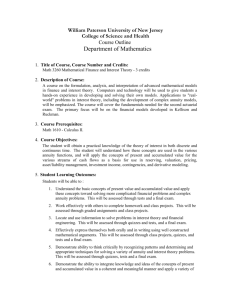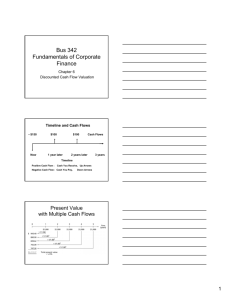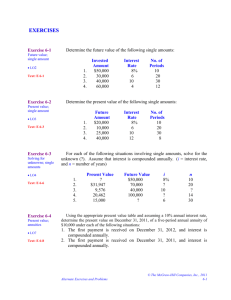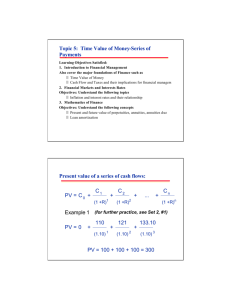April 16, 2002 J. Virgil Mattingly, Jr. General Counsel Board of
advertisement
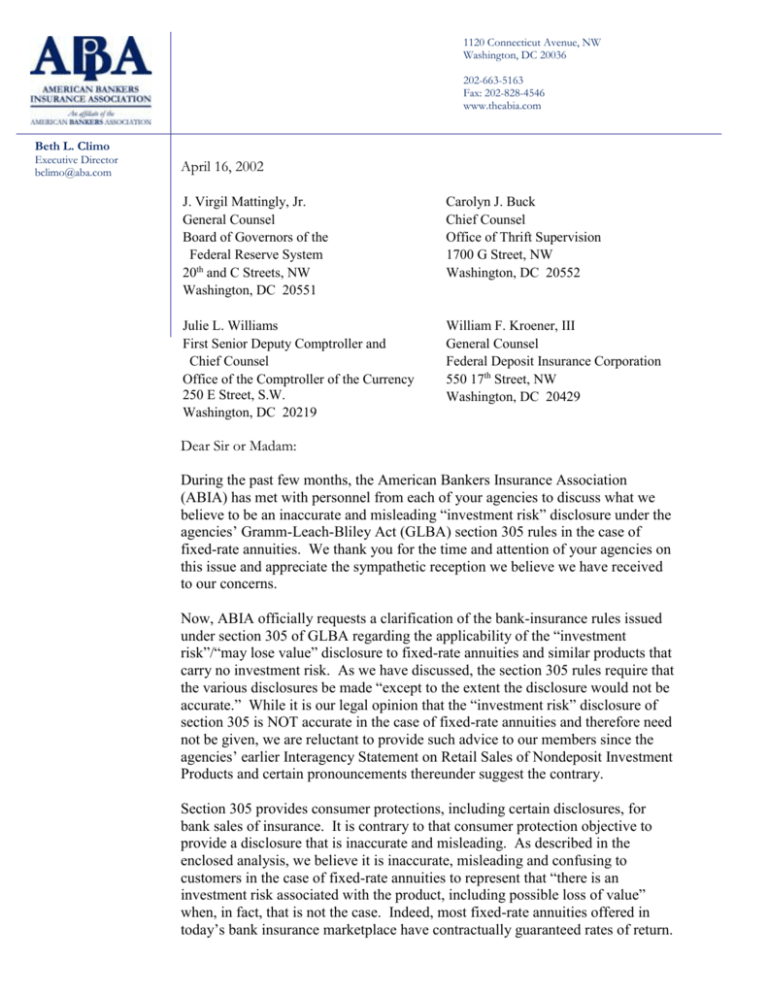
1120 Connecticut Avenue, NW Washington, DC 20036 202-663-5163 Fax: 202-828-4546 www.theabia.com Beth L. Climo Executive Director bclimo@aba.com April 16, 2002 J. Virgil Mattingly, Jr. General Counsel Board of Governors of the Federal Reserve System 20th and C Streets, NW Washington, DC 20551 Carolyn J. Buck Chief Counsel Office of Thrift Supervision 1700 G Street, NW Washington, DC 20552 Julie L. Williams First Senior Deputy Comptroller and Chief Counsel Office of the Comptroller of the Currency 250 E Street, S.W. Washington, DC 20219 William F. Kroener, III General Counsel Federal Deposit Insurance Corporation 550 17th Street, NW Washington, DC 20429 Dear Sir or Madam: During the past few months, the American Bankers Insurance Association (ABIA) has met with personnel from each of your agencies to discuss what we believe to be an inaccurate and misleading “investment risk” disclosure under the agencies’ Gramm-Leach-Bliley Act (GLBA) section 305 rules in the case of fixed-rate annuities. We thank you for the time and attention of your agencies on this issue and appreciate the sympathetic reception we believe we have received to our concerns. Now, ABIA officially requests a clarification of the bank-insurance rules issued under section 305 of GLBA regarding the applicability of the “investment risk”/“may lose value” disclosure to fixed-rate annuities and similar products that carry no investment risk. As we have discussed, the section 305 rules require that the various disclosures be made “except to the extent the disclosure would not be accurate.” While it is our legal opinion that the “investment risk” disclosure of section 305 is NOT accurate in the case of fixed-rate annuities and therefore need not be given, we are reluctant to provide such advice to our members since the agencies’ earlier Interagency Statement on Retail Sales of Nondeposit Investment Products and certain pronouncements thereunder suggest the contrary. Section 305 provides consumer protections, including certain disclosures, for bank sales of insurance. It is contrary to that consumer protection objective to provide a disclosure that is inaccurate and misleading. As described in the enclosed analysis, we believe it is inaccurate, misleading and confusing to customers in the case of fixed-rate annuities to represent that “there is an investment risk associated with the product, including possible loss of value” when, in fact, that is not the case. Indeed, most fixed-rate annuities offered in today’s bank insurance marketplace have contractually guaranteed rates of return. Further, providing such an inaccurate disclosure for products where there is no “investment risk” (e.g., fixed-rate annuities) lessens the consumer protection value of the disclosure with respect to products that have “investment risk” (e.g., variable annuities) by failing to assist consumers in distinguishing the relative risks of these products. Thus, we believe it is imperative that the agencies make clear that the “investment risk” disclosure is not required in connection with sales of fixed-rate annuities or other products that have no investment risk. Thank you again. Sincerely, Beth L. Climo Enclosure cc: James T. McIntyre, Jr., Esq. Chrys D. Lemon, Esq. INVESTMENT RISK ASSOCIATED WITH FIXED-RATE ANNUITIES INTRODUCTION The federal consumer protection regulations issued pursuant to Section 305 of the Gramm-Leach-Bliley Act1 require a “covered person” (a depository institution or a person selling on its behalf) to provide consumers with certain disclosures in connection with the sale of an insurance product or annuity. One of the disclosures a covered person must provide is the following disclosure concerning investment risk: “In the case of an insurance product or annuity that involves an investment risk, there is investment risk associated with the product, including the possible loss of value.”2 (emphasis added) This disclosure must be made “except to the extent the disclosure would not be accurate.”3 The American Bankers Insurance Association (ABIA) believes it would not be accurate to disclose that fixed-rate annuities4 involve an investment risk. Moreover, the plain language of the Gramm-Leach-Bliley Act states that the investment risk disclosure is required only in connection with variable annuities. Nevertheless, since this is an important issue for ABIA and because earlier regulatory pronouncements suggest such a disclosure must be provided, we respectfully request that the federal financial regulators clarify that the investment risk disclosure is not required in connection with the sale of fixed-rate annuities or other types of products that have no investment risk, such as single-premium whole life or term life insurance products. 1 2 3 See 12 C.F.R. Parts 14; 208; 343; and 536. See, e.g., 12 C.F.R. § 14.40(a)(3). See, e.g., 12 C.F.R. § 14.40(a). SUMMARY OF ANALYSIS To require that covered persons make the investment risk disclosure in connection with the sale of fixed-rate annuities fails to distinguish the different risks inherent in fixedrated annuities and variable annuities and misleads consumers with respect to the type of risk actually associated with fixed-rate annuities. Such an interpretation also is contrary to the plain language of the Gramm-Leach-Bliley Act, in which Congress said that the consumer protection regulations only require that the investment risk disclosure be provided “[i]n the case of a variable annuity or other insurance product which involves an investment risk. . . .”5 (emphasis added) The legislative history confirms this plain reading of the statute. Not all annuities have investment risk. The term “investment risk” characterizes a policyowner’s risk of losing all or part of the principal invested in an annuity and/or accumulated income because of market fluctuations. (The annuity “may lose value,” including the loss of principal.) In the case of annuity products, such risk is associated only with variable annuities, for which part (if not all) of a policyowner’s return on his or her investment is directly related to how the policyowner invests the principal and earnings from the annuity, which could include a loss of principal. Fixed-rate annuities typically have guaranteed minimum returns together with guaranteed return of principal features; accordingly, they have no investment risk. Consequently, the only risk the consumer faces is insolvency risk (the issuer experiencing financial difficulties and being unable to meet its contractual obligations). ANALYSIS What is “investment risk?” The term “investment risk” is not defined in statute, but the United States Supreme Court has said that under a fundamental canon of statutory construction, “unless otherwise defined, words will be interpreted as taking their ordinary, contemporary, common meaning.”6 The common meaning of “investment risk” is “the risk arising out of price fluctuations for a whole securities market, for an industrial group, or for an individual security, regardless of the financial ability of particular issuers to pay the promised or expected investment returns.”7 (emphasis added) Within the context of insurance and annuities, investment risk has been defined as “the possibility of a reduction in value of an insurance instrument resulting from a decrease in the value of the assets incorporated in the investment portfolio underlying the insurance instrument.” 8 Investment risk is only a very small subset of the universe of risk. Distinctions between how types of risk are characterized are important in the financial world. For example, both variable annuities and fixed-rate annuities are subject to “insolvency risk.” “Insolvency risk,” which is also commonly referred to as “financial risk” or “repayment (credit) risk,” is very different from “investment risk.” Insolvency risk has been defined as the risk that “arises because the issuers of investments may run into financial difficulties and not be able to live up to their promises or expectations.” 9 In the annuities context, insolvency risk is the risk to a policyowner that an annuity provider will be unable to satisfy future guaranteed annuity payments because it is experiencing financial difficulties. Barron’s also lists several other types of risks that contribute to the universe of financial risk but that are not considered to be investment risk. They include: “Fixed-rate annuities” are sometimes called “fixed annuities.” Gramm-Leach-Bliley Act § 305, adding section 47(c)(1)(A)(ii) to the Federal Deposit Insurance Act (12 U.S.C. § 1831x(c)(1)(A)(ii)). 6 Perrin v. United States, 444 U.S. 37, 42 (1979); see FDIC v. Meyer, 510 U.S. 471, 476 (1994). 7 G. Victor Hallman & Jerry S. Rosenbloom, Personal Financial Planning 186 (5th ed. 1993) [hereinafter “Hallman & Rosenbloom”]. 8 Barron’s Dictionary of Insurance Terms (4th ed. 2000). 9 Hallman & Rosenbloom, supra note 7, at 186. 4 5 actuarial risk (the “risk an insurance underwriter covers in exchange for premiums, such as the risk of premature death”); 10 exchange risk (the “chance of loss on foreign currency exchange”); inflation risk (the “chance that the value of assets or of income will be eroded as inflation shrinks the value of a country’s currency”); interest rate risk (the “possibility that a fixed-rate debt instrument will decline in value as a result of a rise in interest rates”); inventory risk (the “possibility that price changes, obsolescence, or other factors will diminish the value of inventory”); liquidity risk (the “possibility that an investor will not be able to buy or sell a commodity or security quickly enough or in sufficient quantities because buying or selling opportunities are limited”); political risk (the “possibility of nationalization or other unfavorable government action”); and underwriting risk (the “risk taken by an investment banker that a new issue of securities purchased outright will not be bought by the public and/or that the market price will drop during the offering period”).10 Barron’s Dictionary of Finance and Investment Terms (5th ed. 1998). Variable annuities: the policyowner is subject to some investment risk. Variable annuities subject the policyowner to investment risk, because some of the policyowner’s funds are allocated to one or more separate accounts, which bear the risk of the underlying investments held in the account. Those funds are subject to the sole investment authority of the policyowner; the insurer has no investment authority and no obligation with respect to the management of those funds. With respect to those funds, an owner of a variable annuity has the ability to: choose from among several different investment funds [(subaccounts)] with regard to where he or she wishes to place the annuity premiums. The annuity owner also usually has the option of moving the annuity contributions and/or cash values among the various investment funds offered at reasonable intervals. . . . Thus, under this kind of annuity the annuity owner has considerable investment flexibility among the various annuity funds offered. . . . [W]ith variable annuities the investment risks also reside with the annuity owner. In other words, with the flexibility goes the risk.11 (emphasis added) Consequently, a policyowner bears the potential risk of loss of principal from investing in a fluctuating market, such as the stock market – that is, investment risk. If the separate account performs poorly, the policyowner risks losing earnings and potentially the principal.12 Fixed-rate annuities: the policyowner does not face investment risk because the return on the annuity is not subject to market fluctuations. A fixed-rate annuity is a contract between a policyowner and an insurer that requires a policyowner to pay either a lump sum or periodic payments to the insurer to establish the “principal,” from which the insurer guarantees the policyowner a fixed rate of return.13 The insurer allocates all of the principal invested by the policyowner to a general account, and, in return, makes guaranteed periodic payments to the annuitant out of the insurer’s earnings from its investment portfolio held in the general account. In a fixed-rate annuity: the cash value accumulation (or the annuity income) is a stated dollar amount that is guaranteed by the insurance company and on 11 12 13 Hallman & Rosenbloom, supra note 7, at 391. Id. at 393. David Shapiro & Thomas F. Streiff, Annuities 3-4 (1997). which (or with respect to the annuity income) the insurer pays a specified or determinable rate of interest. In effect, it is a fixeddollar, guaranteed-principal kind of investment medium that is in some ways analogous to CDs. The investment authority and investment risk are on the insurance company because it is the insurer that guarantees the cash value (or annuity income) and specifies the interest rate currently being paid on cash value accumulations.14 Consequently, unlike variable annuities, fixed-rate annuities have no “investment risk,” because the payout is guaranteed by the insurer/issuer as part of its general account obligations. In summary, a fixed-rate annuity, with its guaranteed payout, is distinguishable from a variable annuity. While both are subject to insolvency risk, only variable annuities pose investment risk to the annuity purchaser. This distinction is one of the principal differences between fixed-rate annuities and variable annuities. The Gramm-Leach-Bliley Act’s plain language requires the investment risk disclosure only for variable annuities. The provision in the Gramm-Leach-Bliley Act that directed the federal financial regulators to issue consumer protection regulations indicates that Congress understood that only variable annuities are subject to investment risk. Specifically, Congress directed the federal agencies to include in the consumer protection regulations only the following disclosure concerning investment risk: “In the case of a variable annuity or other insurance product which involves an investment risk, that there is an investment risk associated with the product, including possible loss of value.”15 (emphasis added) The House Report on H.R. 10 confirms that Congress intended that the investment risk disclosure only be provided for variable annuities: Section 307 [codified as Section 305 in the Gramm-Leach-Bliley Act] directs the Federal banking regulators to issue final consumer protection regulations. . . . Such regulations shall include: Oral and written disclosures stating that the applicable insurance product is not FDIC insured; in the case of a variable annuity, that the product may involve an investment risk and may lose value. . . .16 (emphasis added) Congress, accordingly, was cognizant of the important differences in the principal types of risks actually associated with variable annuities and fixed-rate annuities. If Congress had wanted fixed-rate 14 Hallman & Rosenbloom, supra note 7, at 391. Gramm-Leach-Bliley Act § 305, adding § 47(c)(1)(A)(ii) to the Federal Deposit Insurance Act (12 U.S.C. § 1831x(c)(1)(A)(ii)). 16 H.R. Rep. No. 106-74, Part III, commentary on Sec. 307. 15 annuities to be covered by the disclosure pertaining to investment risk, it would have referred to annuities in general and not solely to variable annuities. Courts have recognized that fixed-rate annuities are not subject to investment risk. Judicial opinions interpreting federal securities laws confirm the distinction between the types of risk associated with fixed-rate annuities and variable annuities. In Securities and Exchange Commission v. Variable Annuity Life Insurance Co. of America (VALIC),17 the United States Supreme Court acknowledged the distinction between insolvency risk and investment risk. The Securities and Exchange Commission (“SEC”) had argued that, unlike fixed-rate annuities, variable annuities have investment risk and require registration under federal securities laws. Under the Securities Act of 1933 (“1933 Act”), the term “security” is defined to include “any . . . evidence of indebtedness, certificate of interest or participation in any profit sharing agreement, …[or] investment contract.”18 At its inception, the 1933 Act exempted annuity contracts and optional annuity contracts from registration.19 With the advent of the variable annuity, the SEC undertook to differentiate between the two types of annuities, requiring that variable annuities be registered under the 1933 Act because they are subject to investment risk. The resulting case, VALIC, held that companies offering variable annuities may not rely on the exemption from registration in the 1933 Act.20 Fixed-rate annuities, however, remain exempt from registration. In VALIC, the Supreme Court focused on who bears the investment risk – the insurer/issuer or the policy owner – in determining whether to require 17 18 19 20 359 U.S. 65 (1959). Securities and Exchange Act of 1933 § 2(1). Securities and Exchange Act of 1933 § 3(a)(8). 359 U.S. 65 (1959). registration. The Court determined that in fixed-rate annuity contracts, the insurer bears all of the investment risk. In variable annuity contracts, the policyowner bears at least some, and perhaps all, of the investment risk. The Court said: absent some guarantee of fixed income, the variable annuity places all the investment risks on the annuitant, none on the company. The holder gets only a pro rata share of what the portfolio of equity interests reflects – which may be a lot, a little, or nothing. . . . [Issuers of variable annuities] guarantee nothing to the annuitant except an interest in a portfolio of common stocks or other equities – an interest that has a ceiling but no floor.21 The concurring opinion in VALIC illustrates that the distinction between insolvency risk and investment risk dictates how annuities will be regulated under the federal securities laws, a distinction that relates primarily to whether the policyowner’s investment is subject to investment risk. Variable annuities are subject to SEC oversight because they have investment risk, whereas fixed-rate annuities are not. In the concurring opinion, Justice Brennan distinguished insolvency risk from investment risk. He rejected the argument that insolvency risk was worthy of federal regulation under the 1933 Act, saying: Even more unpersuasive is [VALIC’s] argument that even in a [fixed-rate] annuity the policyholder bears the investment risk in the sense that he stands the risk of the company’s insolvency. The prevention of insolvency and the maintenance of “sound” financial condition in terms of fixed-dollar obligations is precisely what traditional state regulation is aimed at. The protection of share interests in a fluctuating, managed fund has received the attention of specific federal legislation.22 21 22 Id. at 71-72. Id. at 90-91. There are important differences between insolvency risk and investment risk as they apply to variable annuities and fixed-rate annuities. The Supreme Court has recognized those differences, and Congress clearly intended to tie the investment risk disclosure only to the offering of variable annuities. Consumers will be confused if they are advised that fixedrate annuities are subject to investment risk. Historically, federal financial regulators have linked annuities’ investment risk to their status as an uninsured product. The federal financial regulatory agencies have generally been of the view that all annuities have investment risk. This view appears to have had its genesis in the 1994 Interagency Statement on Retail Sales of Nondeposit Investment Products (“Interagency Statement”). The Interagency Statement applies to “nondeposit investment products” offered by depository institutions. 23 Depository institutions are required to inform their customers that nondeposit investment products “are subject to investment risks, including possible loss of the principal invested.” The term “nondeposit investment products” is defined to include all annuities 24; accordingly, the disclosure is required for both fixed-rate and variable annuities.25 In the Interagency Statement, the regulators were concerned that depository institutions were offering consumers products that were not insured by a federal governmental agency, such as the FDIC, without providing sufficient information concerning the product’s uninsured status. Specifically, the Interagency Statement provides: The banking agencies believe that recommending or selling nondeposit investment products to retail customers should occur in a manner that assures that the products are clearly differentiated from insured deposits. Conspicuous and easy to comprehend disclosures concerning the nature of nondeposit investment products and the risk inherent in investing in these products are one of the most important ways of ensuring that the differences between nondeposit products and insured deposits are understood. . . . Disclosures with respect to the sale or recommendation of these products should, at a minimum, specify that the product is . . . subject to investment risks, including possible loss of the principal amount invested. 26 (emphasis added) The implication of these two paragraphs is that a product sold by a depository institution that is not insured by the federal government is inherently subject to investment risk. The preamble to a final rule issued in December 1998 confirms this FDIC view: It is the FDIC’s view that FDIC-insured deposits differ from savings bank life insurance products and annuities because investors in such products are exposed to a possible loss of the principal amount invested. The Interagency Statement does not distinguish between the relative loss exposure presented by various nondeposit investment products. The distinction is simply between insured deposits and other investment products. Savings bank life insurance, other insurance products, and annuities contain an investment risk component exposing the investor to a loss of principal. . . . Further, investors in nondeposit products are exposed to more than market risks.27 (emphasis added) It is worth noting, however, that in its “Manual of Examination Policies,” the FDIC defines fixed-rate annuities as: insurance products that guarantee fixed dollar payments, typically until death. The insurance company guarantees both earnings and principal. Fixed annuities are generally not considered securities, contain credit risk, and are regulated by state insurance commissioners.28 (emphasis added) 23 24 25 26 27 28 Interagency Statement at 5. Id. Id. Id. at 5-6. 63 Fed. Reg. 66,289 (Dec. 1, 1998). See http://www.fdic.gov/regulations/safety/manual/98NDIP.htm, at p. 3. Moreover, the FDIC has concluded that whole life insurance and universal life insurance are considered nondeposit investment products under the Interagency Statement, because they have an “investment component.” However, calling a product a “nondeposit investment product” because it is not FDIC insured does not in fact clothe that product with “investment risk,” when such risk is not an inherent characteristic of the product, as is the case with a fixed-rate annuity and certain insurance products. The FDIC does not consider term life insurance, which is not FDIC insured, to be a nondeposit investment product because it has no investment component.29 Confusing investment risk with insolvency risk ignores the fact that insolvency risk is similar for all of these products. 30 CONCLUSION There is a fundamental difference between “insolvency risk” and “investment risk.” “Insolvency risk” accompanies all investment products, as well as insurance, and relates only to the financial soundness of the product provider. “Investment risk” subjects an owner of an annuity to potential losses in investment principal due to market fluctuations, and the United States Supreme Court has confirmed this distinction. If the Gramm-Leach-Bliley Act Section 305 consumer protection regulations are interpreted to require that a covered person disclose that fixed-rate annuities and other similarly-situated products are subject to “investment risk” and, therefore, a “possible loss of value,” such a disclosure would be inaccurate and inconsistent with the scope of the disclosures required by the Gramm-Leach-Bliley Act. The federal consumer protection regulations already address the issue of insolvency risk by requiring two disclosures for all annuities: One requires a covered person to disclose that annuities are not guaranteed by the depository institution, and the other requires disclosure that they are not insured by the FDIC or any other agency of the United States. With respect to fixed-rate annuities, no other type of risk needs to be addressed. For the disclosure regarding investment risk to be meaningful and accurate, it should be provided only when the annuity is actually subject to investment risk.31 Likewise, such a disclosure should not be required for other similarly-situated insurance products. Ironically, requiring such a disclosure when there is no need for one would have the unintended effect of confusing, if not harming, consumers by lessening their ability to distinguish between products where there is a guaranteed return and those where there is a potential loss of principal and accumulated income due to market fluctuations, i.e., fixed-rate annuities versus variable annuities. Finally, one approach the regulators might want to consider for distinguishing between those products for which an investment risk disclosure should be provided and those for which it should not would be to adopt a “bright-line” rule based on federal securities laws. Under such an approach, the investment risk disclosure would be appropriate only for those annuities and insurance products required to be registered under the Securities Act of 1933. The industry needs guidance to determine when the investment risk disclosure must be given, and a “bright-line” rule would satisfy that need. MCINTYRE LAW FIRM, PLLC 29 BARNETT & SIVON, P.C. FDIC Financial Institution Letter 80-98 (July 16, 1998). Indeed, bank deposits are insured by the FDIC only up to $100,000. To the extent an individual’s deposits in a particular bank exceed $100,000, they subject the depositor to a new type of risk: the risk of the depository institution failing, which is insolvency risk, not investment risk. Similarly, in case of the insolvency of an insurance company, the present value of annuity benefits, including cash surrender and withdrawal values, is backed by guarantee associations in most states up to $100,000, according to the National Organization of Life and Health Insurance Guaranty Associations. (National Organization of Life and Health Insurance Guaranty Associations, What Happens When an Insurance Company Fails?) As is the case with bank CDs, the mere fact that the present value of annuity benefits in a fixed-rate annuity exceeds the amount backed by a state guaranty association does not mean that the annuity is subject to investment risk, only that it – like a bank CD – is subject to insolvency risk to the extent there is no governmental backing of the product. 31 The fact that the Interagency Statement requires such a disclosure for all annuities should not dictate how the consumer protection regulations are interpreted. As indicated in the consumer protection regulations, “in the event of a conflict between the Interagency Statement and the final rules, the rules will prevail.” 65 Fed. Reg. 75,823, col. b. 30 MCINTYRE LAW FIRM, PLLC APRIL 16, 2002 BARNETT & SIVON, P.C.



